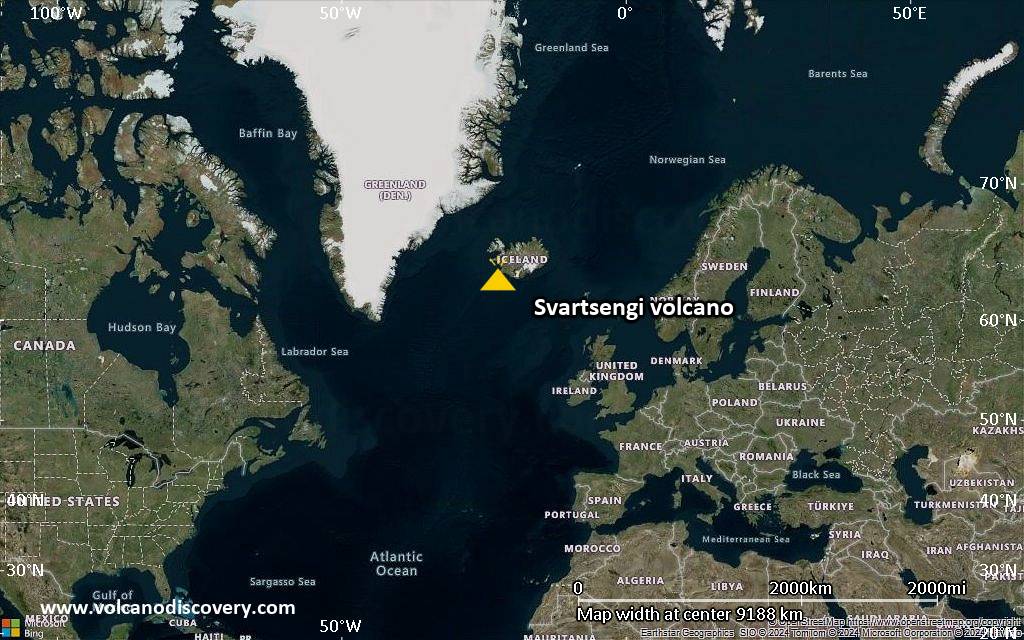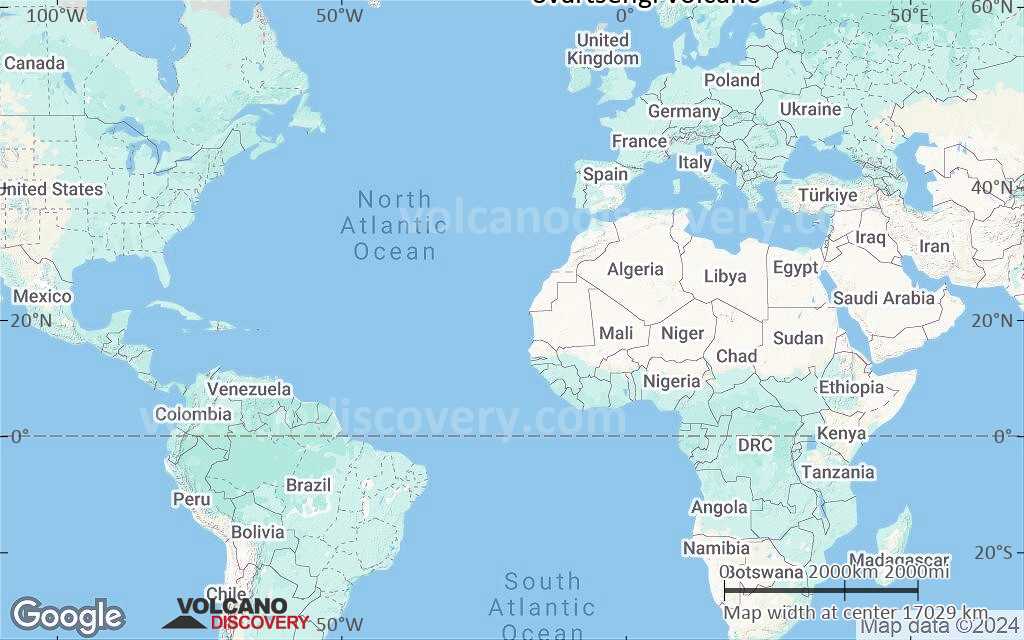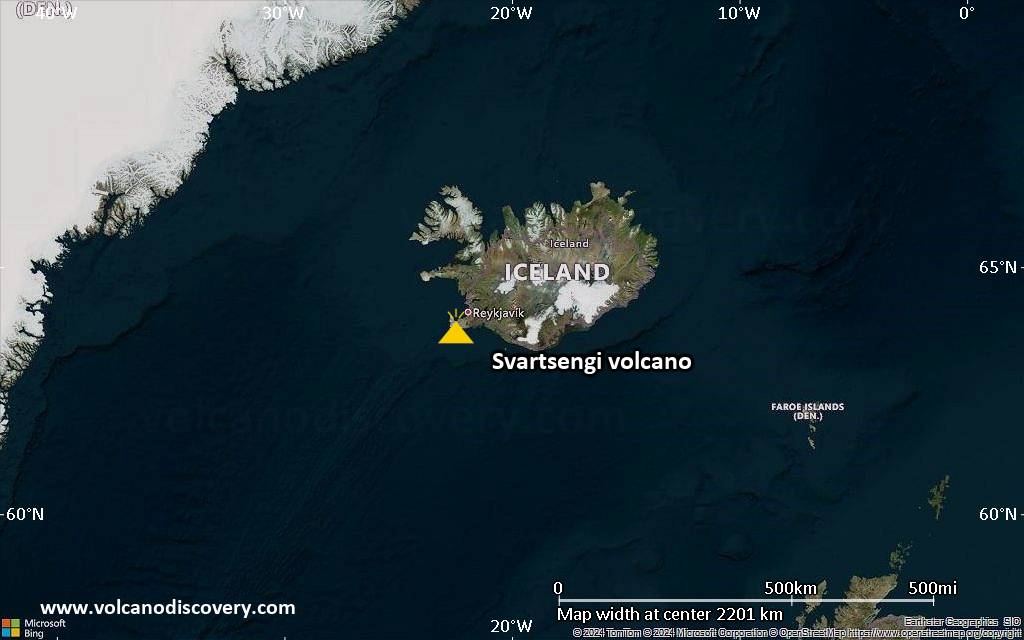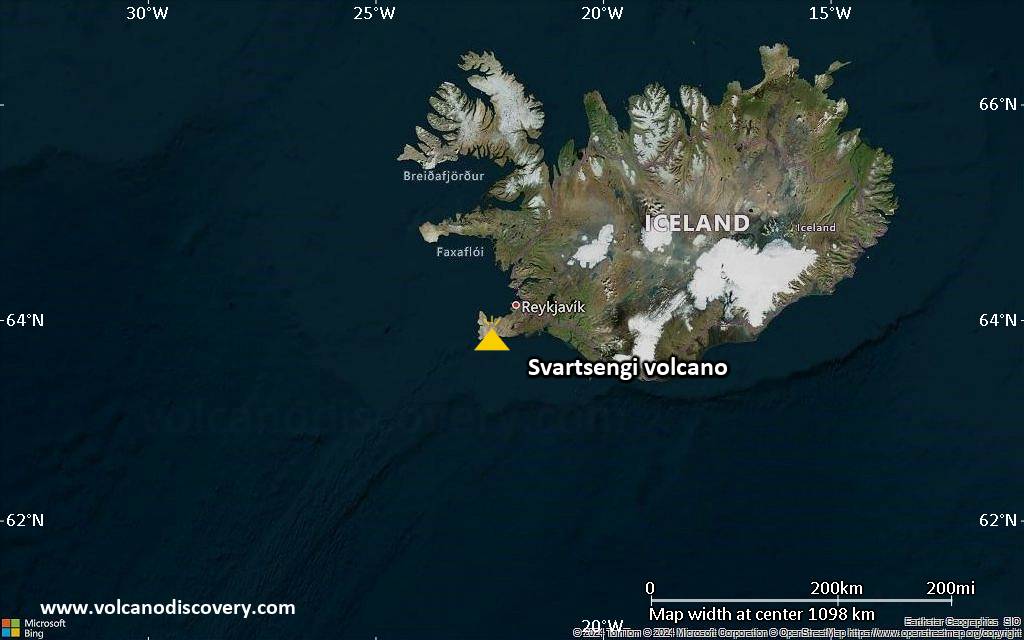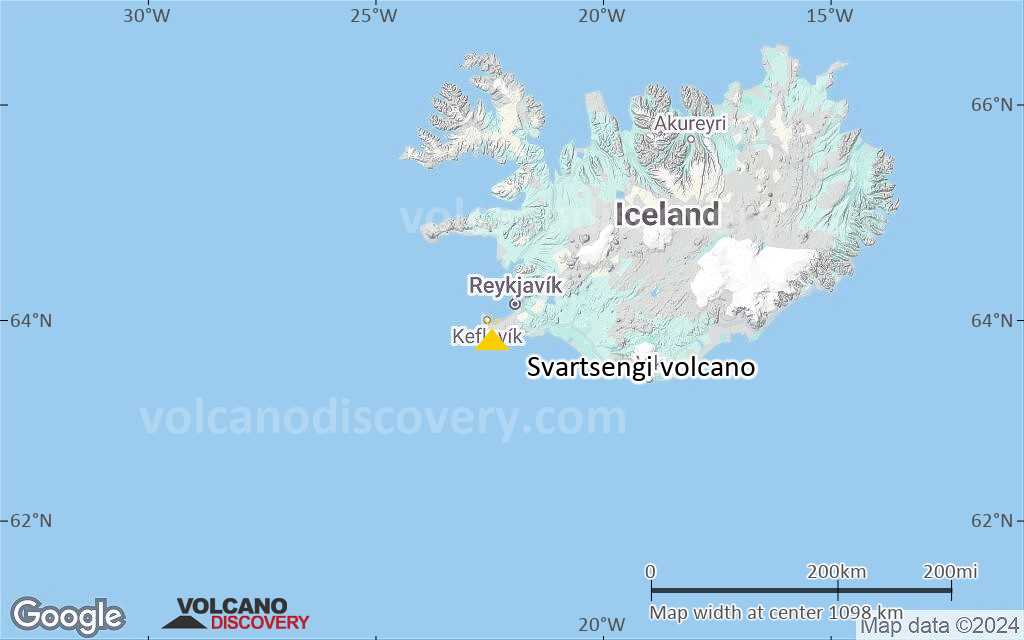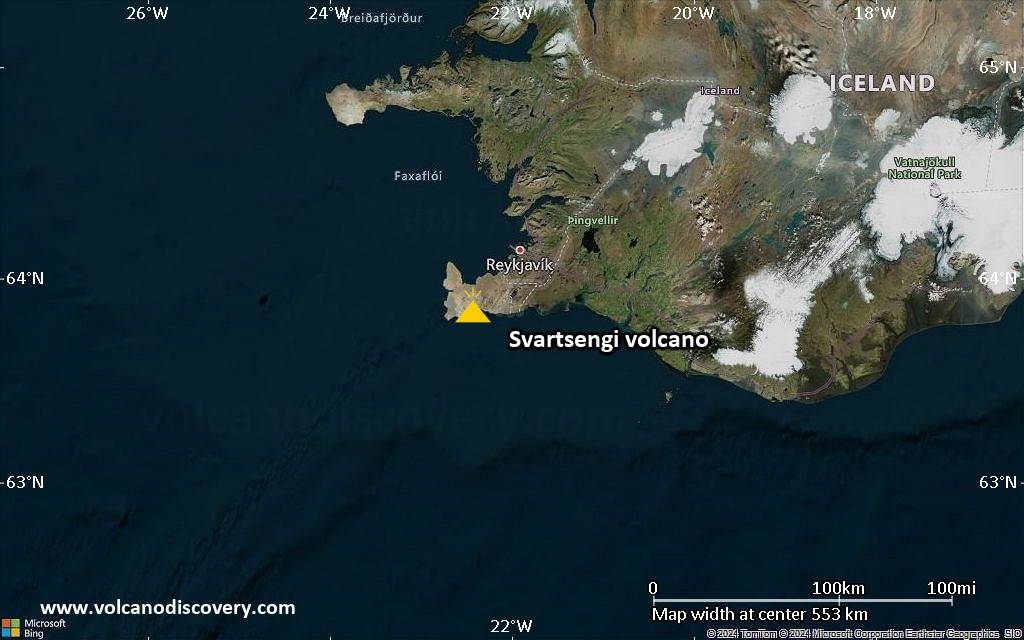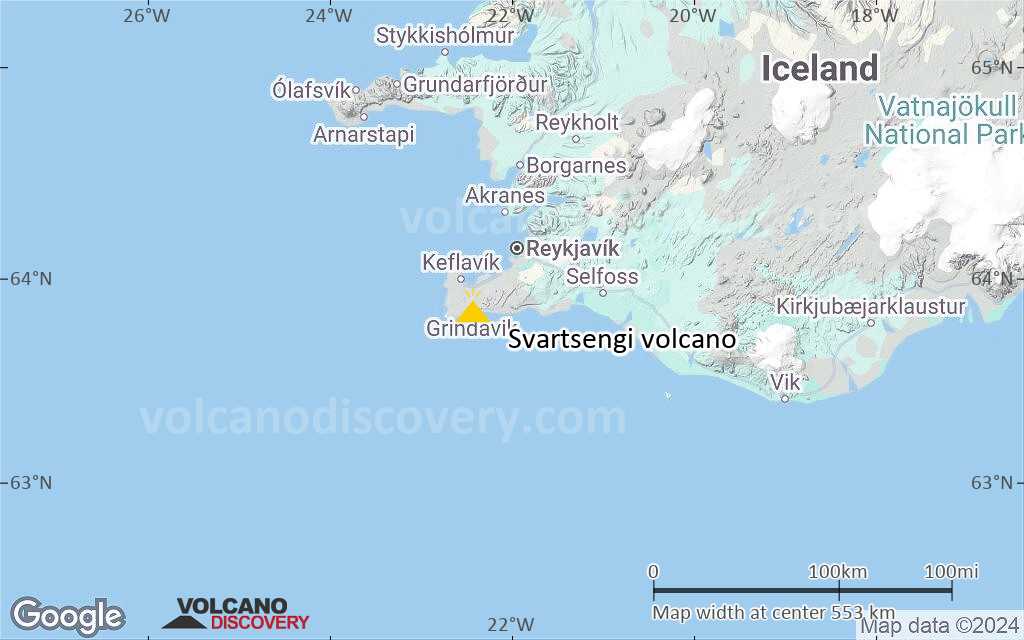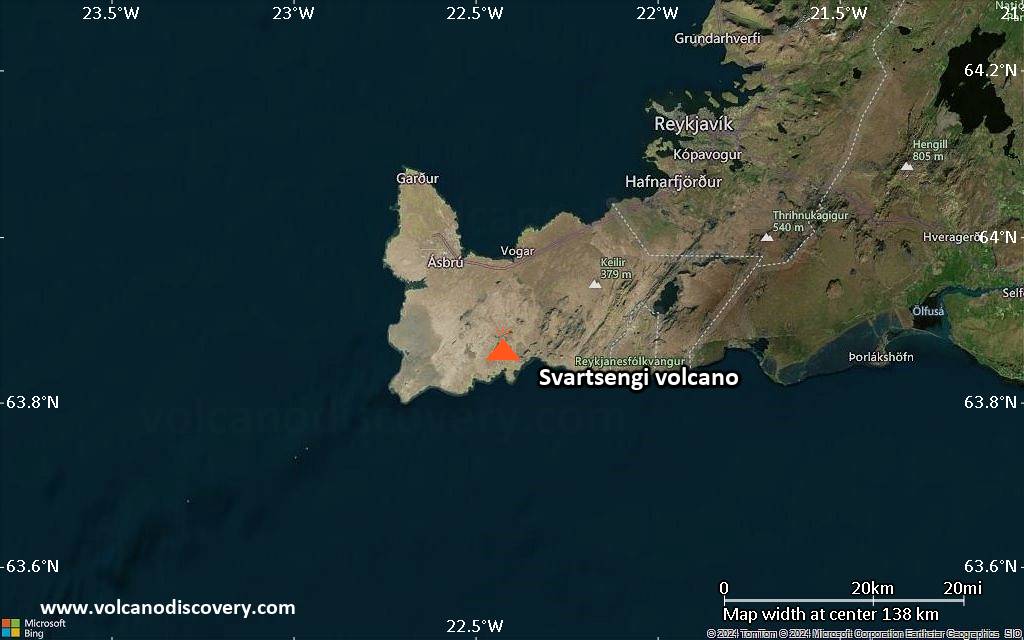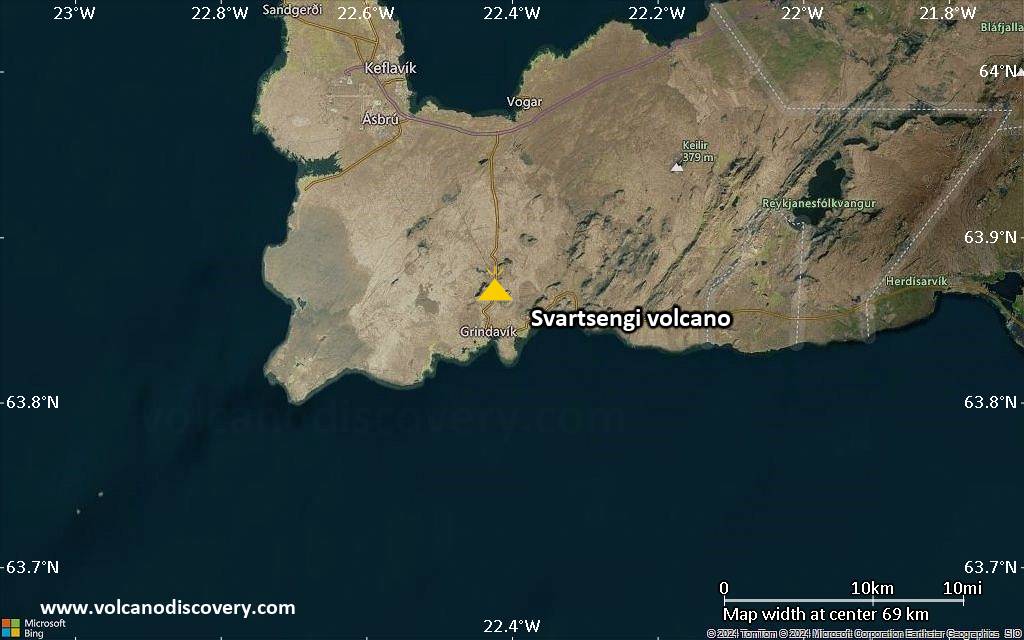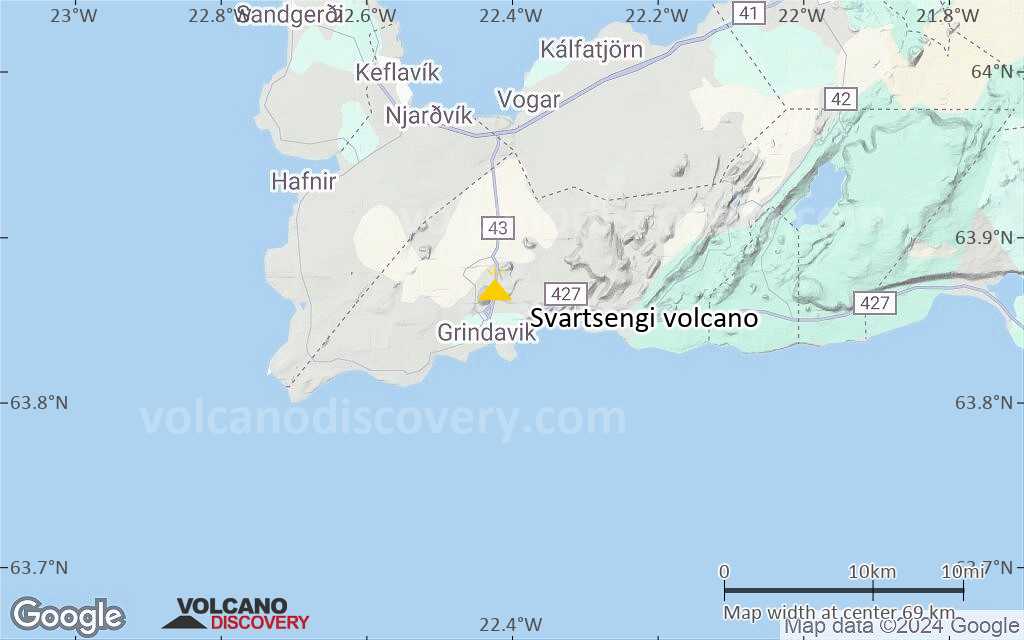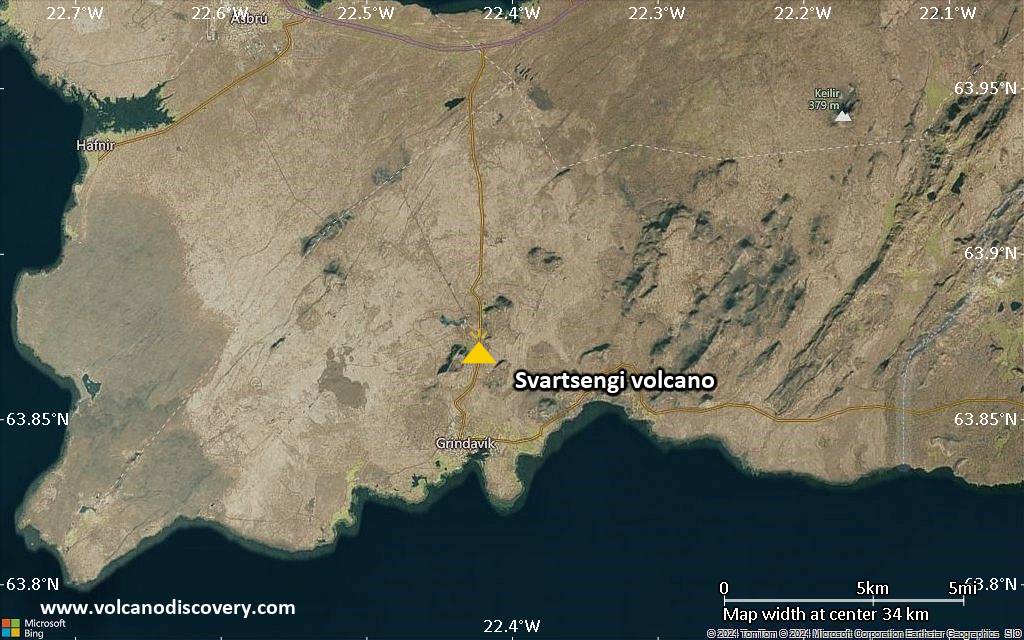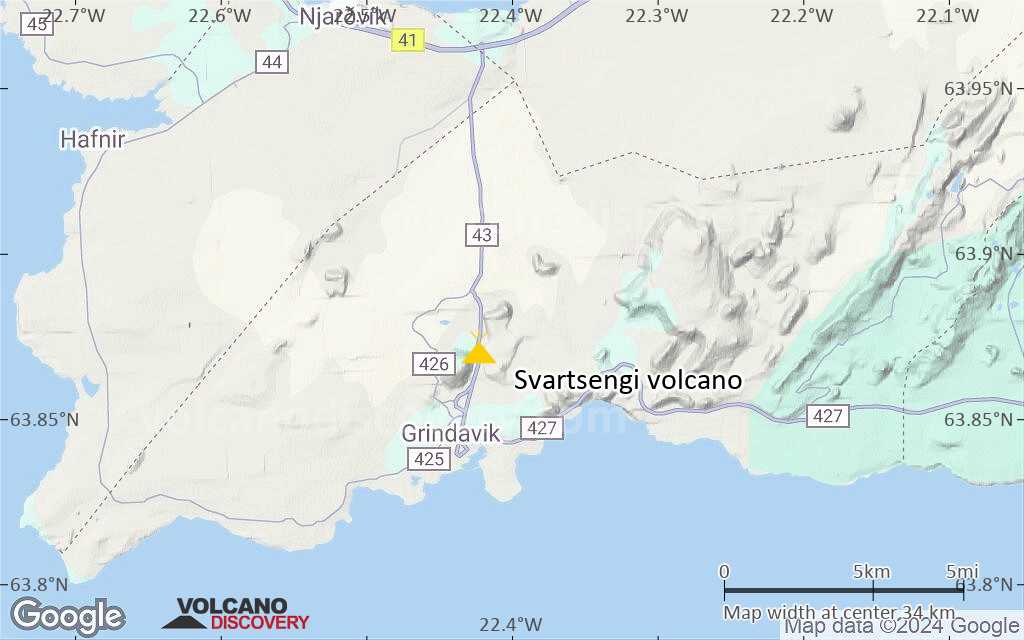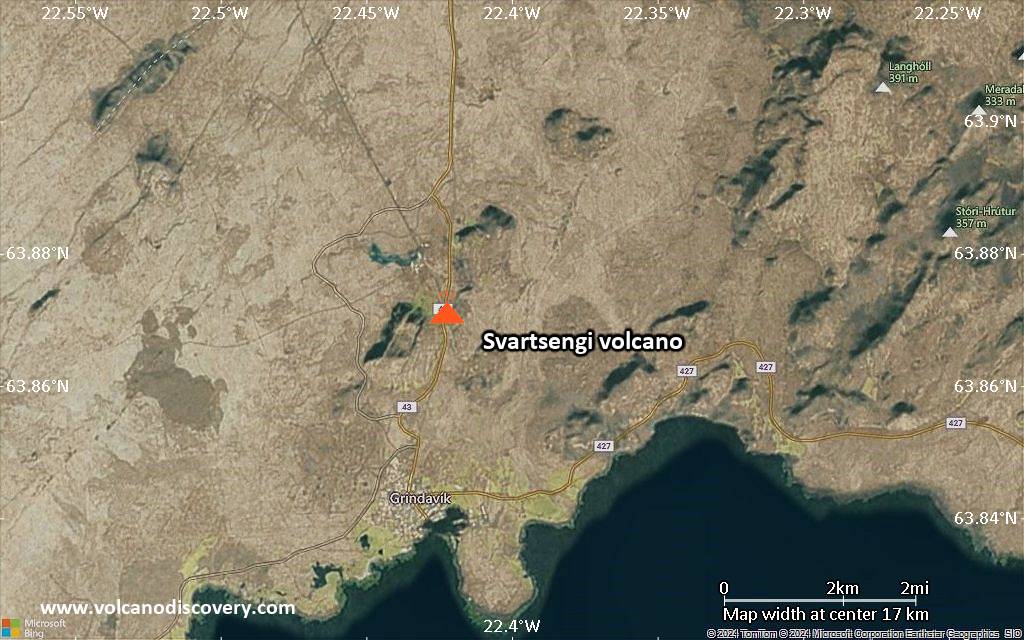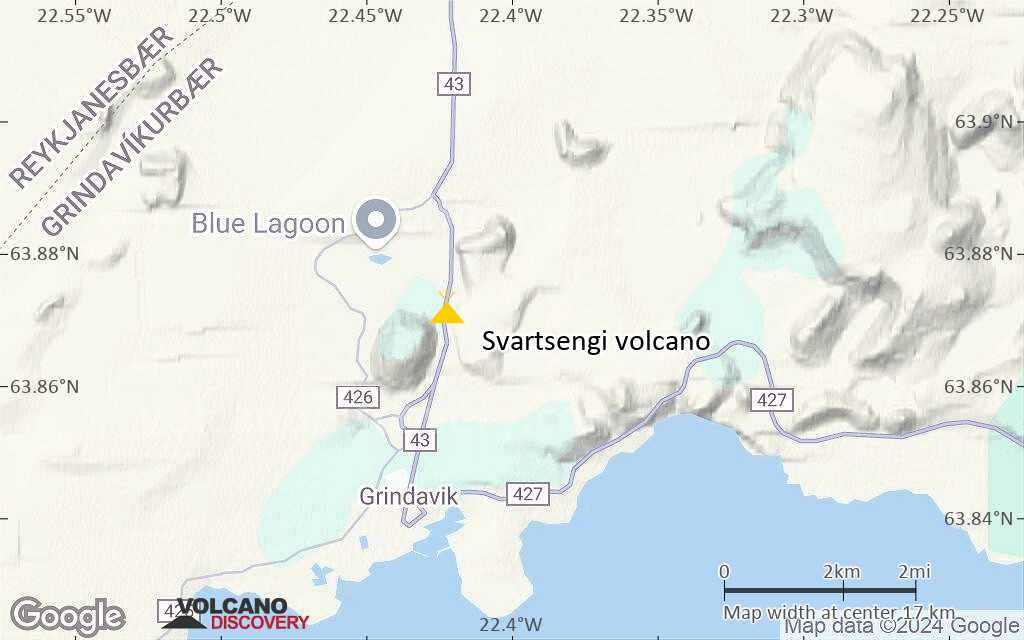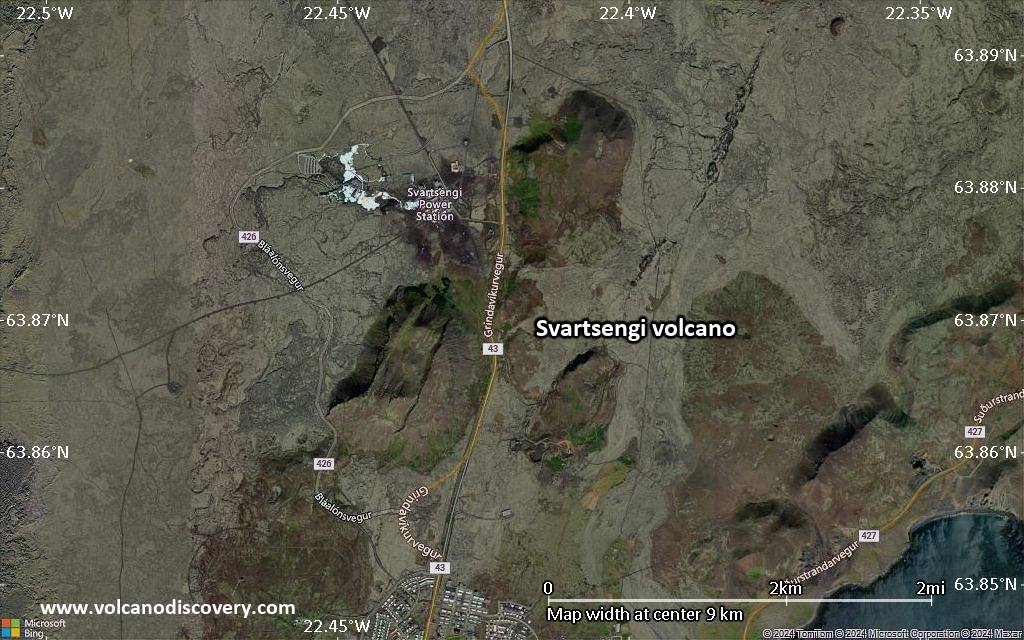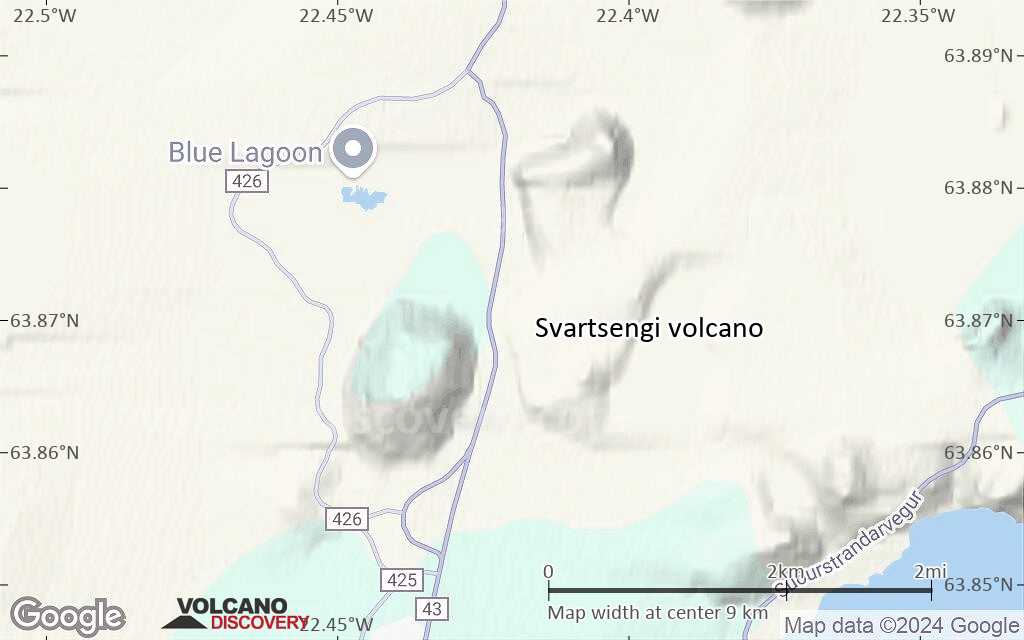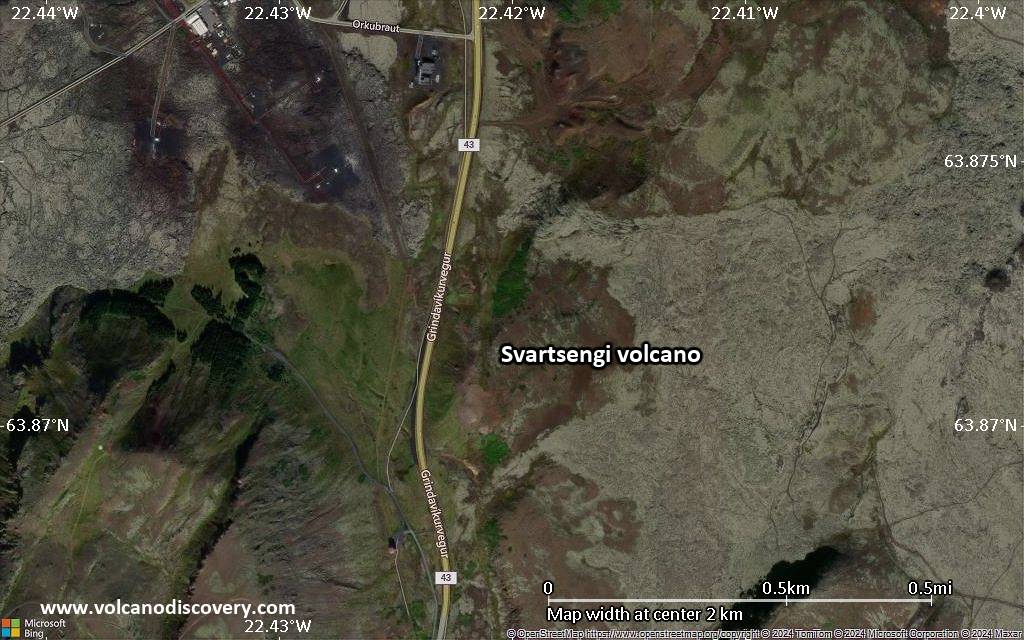Svartsengi Volcano
Svartsengi volcano on the Reykjanes peninsula is one of several major volcanic fissure systems that align along the axis of the Reykjanes Peninsula in SW Iceland. They form the southwestern rift zone where the mid-Atlantic Ridge emerges over water. Over the past 4,000 years, volcanic activity in this area appears to have been occurring during periods with intense and frequent eruptions alternating with repose intervals of several centuries.
After about 800 years of repose, a new period of activity on the peninsula started in 2021. 3 eruptions occurred from the neighboring Fagradalsfjall volcano in 2021-2023, followed by a series of so far 7 new fissure eruptions from the Svartsengi volcano since December 2023.
Svartsengi volcano eruptions: 1211, 1226, 2023 (Dec), 2024 (Jan), 2024 (Feb), 2024 (Mar), 2024 (May-June), 2024 (Aug-Sep), 2024 (Nov-Dec), 2025 (April 1-2)
Latest nearby earthquakes
| Date and Time | Mag / Depth | Distance / Location | |||
|---|---|---|---|---|---|
| Oct 7, 02:57 am (Reykjavik) | 1.2 4.5 km | 20 km (13 mi) to the E | Info | ||
| Oct 7, 01:29 am (Reykjavik) | 1.2 4.5 km | 20 km (13 mi) to the E | Info | ||
| Monday, October 6, 2025 GMT (5 quakes) | |||||
| Oct 6, 08:14 pm (Reykjavik) | 1.0 4.8 km | 19 km (12 mi) to the E | Info | ||
| Oct 6, 03:57 pm (Reykjavik) | 1.0 13 km | 18 km (11 mi) to the E | Info | ||
| Oct 6, 03:49 pm (Reykjavik) | 0.6 5.4 km | 20 km (13 mi) to the E | Info | ||
| Oct 6, 01:19 pm (Reykjavik) | 0.6 4.7 km | 19 km (12 mi) to the E | Info | ||
| Oct 6, 01:08 pm (Reykjavik) | 0.8 3.3 km | 16 km (9.9 mi) to the E | Info | ||
| Saturday, October 4, 2025 GMT (2 quakes) | |||||
| Oct 4, 02:13 pm (Reykjavik) | 3.0 4.2 km | 18 km (11 mi) to the E | Info | ||
| Oct 4, 02:12 am (Reykjavik) | 2.1 4.2 km | 19 km (12 mi) to the E | Info | ||
Significant volcanic eruptions: Svartsengi volcano
Additionally, there are 3 uncertain or discredited eruptions from Svartsengi volcano.
| Date | Note | VEI | Deaths | Damage | ||
|---|---|---|---|---|---|---|
| Sundhnúkagígar, Svartsengi fissure swarm Historical obs./docs. | 1 | Info | ||||
(eruption | Sundhnúkagígar, Svartsengi fissure swarm | 1 | Info | |||
(eruption | Sundhnúkagígar, Svartsengi fissure swarm | 1 | Info | |||
(eruption | Sundhnúkagígar, Svartsengi fissure swarm | 1 | ||||
(eruption | Sundhnúkagígar, Svartsengi fissure swarm | 1 | ||||
(eruption | Sundhnúkagígar, Svartsengi fissure swarm | 1 | ||||
(eruption | Sundhnúkagígar, Svartsengi fissure swarm | 1 | ||||
(eruption | Sundhnúkagígar, Svartsengi fissure swarm | 1 | ||||
(eruption | Sundhnúkagígar, Svartsengi fissure swarm | 1 | Info | |||
(eruption | Sundhnúkagígar, Svartsengi fissure swarm | 1 | Info | |||
| 2023 Dec 18 (eruption | Historical obs./docs. | 0 | 1 | moderate | Info | |
?? | Uncertain Eruption | ? | ||||
?? | Uncertain Eruption | ? | ||||
| Reykjaneshryggur (Eldeyjarbodi) Historical obs./docs. | 3 | |||||
| Reykjaneshryggur (Nyey) Historical obs./docs. | 3 | |||||
Discredited Eruption | ||||||
| Reykjaneshryggur (near Eldeyjar Islands) Historical obs./docs. | 2? | |||||
| Reykjaneshryggur, Arnarsetur, Illahraun Historical obs./docs. | 1 | |||||
| Reykjaneshryggur Historical obs./docs. | ? | |||||
| Reykjaneshryggur Historical obs./docs. | 3 | |||||
| Reykjaneshryggur Historical obs./docs. | 4 | |||||
| Reykjaneshryggur Historical obs./docs. | 3 | |||||
| Stampar, Karlsgigur Historical obs./docs. | ? | |||||
| Vatnsfellsgigur Historical obs./docs. | 3? | |||||
| Reykjaneshryggur Historical obs./docs. | 2 | |||||
Eruptions of Svartsengi volcano
...more info
...more info
The fifth eruption of the series began on 29 May 2024 and lasted for 24 days. Its lava flows caused damage to power lines and cut off several road sections
...more info
...more info
The second eruption of the 2023-24 series began at approximately 7:57 UTC local time on 14 Jan 2024 morning from a fissure located 400–500 m (1,300–1,600 ft) north of Grindavík. It followed a seismic swarm about 5 hours earlier and produced lava flows that crossed some of the constructed barriers and destroyed three homes.
Fortunately, it only lasted approx. 36 hours and more damage was thus avoided.
After the series of the 2021, 2022, and 2023 fissure eruptions at Fagradalsfjall, activity on the by now re-awakened Reykjanes rift zone of SW Iceland moved west to the Eldvörp–Svartsengi volcanic system, north of Gríndavik town and just a few km east of the famous Blue Lagoon area.
A first eruption occurred in Dec 2023, followed by an (ongoing) series of so far 7 eruptions until December 2024 (as of January 2025). ...more info
Svartsengi Volcano FAQ
+When was the last eruption of Svartsengi volcano?
The last confirmed eruption of Svartsengi began in 2023 and is continuing (as of October 2025).
+How often does Svartsengi volcano erupt?
Since 1179 AD, Svartsengi volcano has had at least 12 historically documented eruptions. This means that it erupts on average every 71 years.
Many eruptions of Svartsengi have lasted more than one year. In total, the volcano has been in eruption during 16 out of 846 years until now. In other words, Svartsengi has been active at least one in 52.9 years on average. Note that this value is likely an underestimate, because the known history of eruptions from Svartsengi is likely incomplete, especially further back in time.
+How active is Svartsengi volcano at present?
Svartsengi volcano is occasionally active: Since 1900, it has had 3 eruptions, and been active during 3 years out of 126 as of now. This means, Svartsengi has been in eruption one in 42 years on average. The latest eruption is still continuing at present.
+When was the largest eruption of Svartsengi volcano?
The largest eruption of Svartsengi volcano in historic times occurred around 1226 AD - 1227 AD. It ranks as a sub-plinian eruption with a magnitude 4 on the VEI (Volcanic Explosivity Index) scale.
Latest satellite images
Svartsengi Volcano Maps
